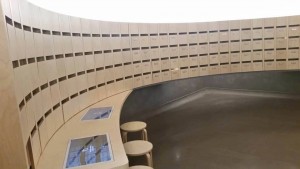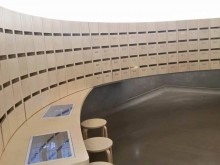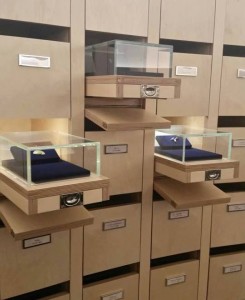
By Vanessa Campoli (Istituto Lorenzo de’ Medici)
In 2008 Museo Degli Innocenti took the initiative to create a more interactive museum experience. After an eight year restoration, costing 12.8 million euro, the museum reopened its doors to the public on June 23, 2016. This restoration project allowed for new technology to be added and adapted for the needs of the museum. One of the most notable exhibitions is the display of 140 segni, or marks, on the bottom floor. The segni are objects left behind on children who were abandoned at the once hospital in hopes that a parent may later be able to identify their child. This large space is shaped as a semi-circle and contains the restored and catalogued items in drawers that can be opened and explored. It has four touchscreens with chairs on either side of the wall display. These touchscreens encourage the visitor to sit and give attention to the touchscreen in front of them, instead of glancing at individual labels. Each visitor is encouraged to have a personal connection with one of the abandoned children by choosing a name on the screen and reading the story of the child that was left at the hospital. These stories have corresponding drawers that allow the visitor to connect the story of a child with the object.
The touchscreens are thought to enhance visitor interactivity by connecting the museum visitor with one of the orphan children. While the fundamental basis of the concept is there, this display lacks organization. The segni and the stories do not always correspond, and, due to the fact that there is no real organization of the named boxes, the ones that do have both segni and displayed story are often hard to find. While it is interesting to read the stories of the children who were left behind, knowing if they have a segni would be very helpful to the user. By not making it clear, the user only gets to have half of the experience, especially if the name chosen solely tells a story. It would be easier to divide the stories in different areas or on separate touchscreens that would allow for a distinction between those with segni and those without. By doing this, the museum would allow a continuation of the history of the building, as well as create a more fluid transition from spaces for the visitor.
While Museo Degli Innocenti has made strides in creating a more interactive atmosphere for its visitors, there is potential for improvement. By using their new technology to create fluidity from exhibition space to exhibition space, the museum could greatly benefit, with better traffic flow of the visitor as well as with a more complete understanding and appreciation for the museum from the view of the audience. These personal connections that the Innocenti strives to create could ultimately distinguish it amongst its peers in Florence and could easily top the list of tourists so long as the distribution of technology and interactive exhibits create a complete museum experience.
Traduzione di Tania Mio Bertolo (Università degli Studi di Firenze)
Risale al 2008 la decisione di creare presso il Museo degli Innocenti un percorso espositivo di carattere interattivo. A seguito di un restauro di otto anni, del valore di 12.8 milioni di euro, il 23 giugno 2016 il museo ha riaperto le sue porte al pubblico. Il progetto di restauro e riallestimento ha previsto l’inserimento di innovativi strumenti tecnologici per migliorare il percorso espositivo ed adeguarlo alle nuove esigenze dei musei. Uno degli esempi più significativi si trova al piano seminterrato ed è la parete dei 140 segni, ovvero di quegli oggetti personali che i genitori lasciavano ai bambini al momento dell’abbandono come segni distintivi per poterli riconoscere un domani. La parete delimita uno spazio semicircolare, ed in essa gli stessi segni restaurati e catalogati sono conservati in piccoli cassetti che il visitatore può aprire ed esplorare. Quattro touchscreen ed alcune sedie sono distribuiti su entrambe le estremità della parete, invitando così il visitatore a sedersi ed interagire con gli schermi tattili, invece che leggere una ad una le targhette dei 140 cassettini. Il visitatore è incoraggiato ad instaurare un legame personale con uno o più tra i bambini abbandonati scegliendo un nome sullo schermo e leggendone la storia. A ciascuna storia corrisponde un cassetto, a ciascun orfano corrisponde un oggetto.
I touchscreen sono pensati per coinvolgere attivamente il visitatore, invitandolo a creare un legame con uno tra i bambini. Benchè l’idea sia valida e l’intenzione interattiva manifesta, la sua concretizzazione risulta incompleta a causa della disorganizzazione del software dei touchscreen. I segni e le storie non sempre corrispondono in maniera univoca, ed inoltre non sempre è facile trovare il cassetto associato ad una delle storie narrate poiché le vicende riportate negli schermi non esauriscono il totale dei contenitori. Venire a conoscenza delle storie di questi orfanelli è tanto interessante per il visitatore quanto lo è il capire se con loro era stato abbandonato qualche oggetto identificativo. In questo modo l’interazione tra il visitatore ed il percorso espositivo viene espletata solo a metà. Sarebbe forse stato più utile dedicare alcuni touchscreen solo alle vicende di quei bambini ai quali appartenevano i segni, ed altri esclusivamente alle storie degli orfanelli abbandonati senza oggetti identificativi. In questo modo il museo avrebbe scelto la via più semplice per tramandare e far rivivere la storia dell’istituto, ed inoltre avrebbe reso più fluido il percorso espositivo.
Sebbene il Museo degli Innocenti abbia fatto passi da gigante nell’allestimento di un percorso interattivo, ci sono ancora molti aspetti da migliorare. Il museo potrebbe trarre grandi vantaggi dall’utilizzo di questi innovativi strumenti tecnologici per rendere ancor più agili i passaggi tra i vari spazi espositivi, migliorando la gestione del flusso dei visitatori ed immedesimandosi nel punto di vista di quest’ultimo per la percezione del museo stesso. Le succitate connessioni che il Museo degli Innocenti cerca di stimolare tra il visitatore e le storie degli orfanelli, potrebbero costituire la cifra distintiva di questo museo. E magari, se è vero che l’uso della tecnologia e l’esperienza interattiva in uno spazio espositivo rendono più completa la visita stessa, permettere al Museo degli Innocenti di essere annoverato tra i preferiti dei turisti.

